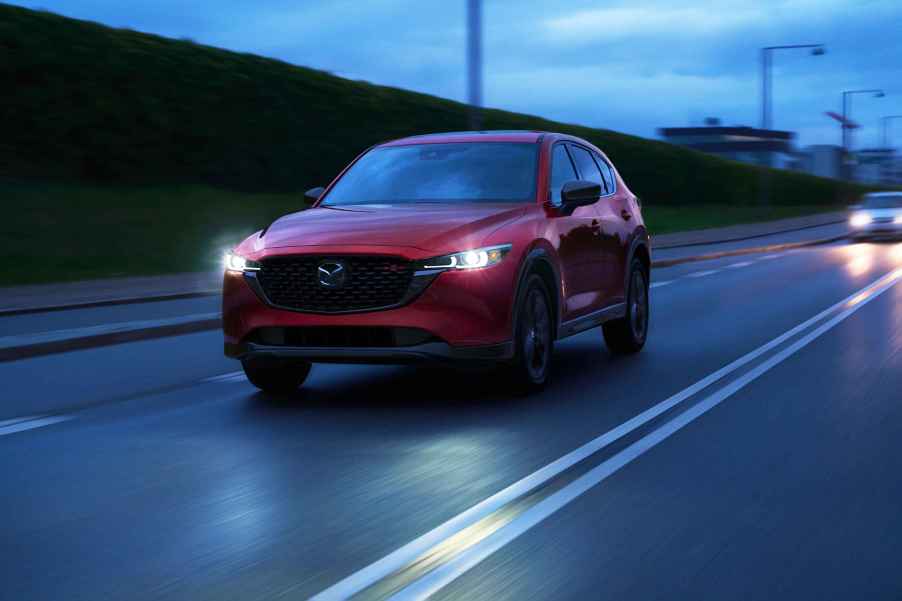
The 2024 Mazda CX-5 is Still Good Enough to Keep it Alive
Mazda recently killed off its CX-9 to pave the way for the bigger and more upscale CX-90. It is reasonable to suspect the same fate would meet the CX-5 with the introduction of the CX-50 — the discontinuation of the old guard to pave the way for its new sibling. Mazda hasn’t announced such a fate for the CX-5 yet. It’s easy to see why after I recently tested the 2024 CX-5 following a week with the 2023 CX-50. It might not make much business sense from the outside to cannibalize your own customer base with two similar compact SUVs, but the CX-5 still stands tall(er) despite its new sibling.

The CX-5 and CX-50 share much in common, including the same platform and powertrains. A notable difference is their size and styling. The CX-5 carries the classic upscale, graceful styling of Mazda while the CX-50 sports a more athletic, adventure-ready appearance. The CX-50 is a bit wider, longer and lower than its older brother with a more aggressive front fascia and cladding all around.
The CX-50’s added cargo and passenger space is negligent, however. The CX-50’s cargo area accommodates 31.4 cubic feet of stuff, just 0.6 more cubes than the CX-5. In fact, the CX-5 has some real-world size advantages. For instance, its taller height means you’re a bit less likely to bash your head on the door frame when strapping a kid into a car seat. Trust me. The CX-5’s higher ride height and taller front windscreen slightly improves outward visibility and interior headroom.
There’s no questioning the CX-50 feels more modern inside, though. The cabins aren’t monumentally different, but the CX-50 sports a revised dash that’s a bit more driver focused, for instance.
Engine choices for the CX-5 are the same as the CX-50, and all-wheel drive is standard in either model. The standard unit is 2.5-liter four cylinder developing 187 horsepower. Buyers can upgrade to a turbocharged version dishing out 256 horsepower in upper trims. The turbo version is the way to go if you can swing the dough. It delivers smooth and peppy acceleration around town, and it pairs well with the smart-shifting six-speed automatic.
The CX-50 feels slightly more agile on the road, but that could be the mind playing because it’s lower and wider. The CX-5, meanwhile, feels more composed over road imperfections, delivering a more supple ride quality. That is no mind trick. Your backside will feel the difference.
Both offer serious Mazda “Zoom Zoom” spunk either way with lively performance, composed handling and exceptional steering feel for the class. It’s hard to argue against either model as the de facto choice for enthusiasts shopping in the mainstream compact SUV market.
These two Mazda compact SUVs may be similar, but they are aimed at two different segments of compact SUV buyers. Mazda has even said the CX-50’s updates for 2024 — suspension tweaks, most notably — are “all in line with…encouraging more all-terrain adventures.”
As such, the CX-5 remains an appealing choice for those who stay on the beaten path. Its advantages, though slight, include a more compliant ride, better visibility and more headroom. And buyers seem to have taken notice the CX-5 and CX-50 aren’t two peas necessarily from the same pod. Mazda’s lates monthly sales figures shows it outselling the CX-50 by about four-to-one. That’s in-keeping with more buyers seeking a compact SUV for tackling the urban jungle versus the wilderness.
There isn’t a debate between the CX-9 and CX-90 — the new model is unquestionably better. The same can’t be said for the CX-5 and its new compact companion. The CX-5 does not have the same novelty as the CX-50, but it’s still a hugely compelling option in its class.



